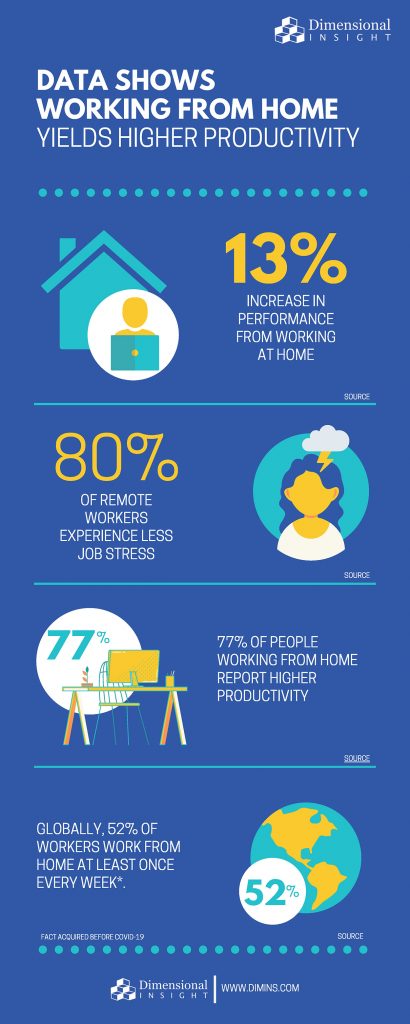For many people in the software industry, working remote is to some degree conventional and even encouraged. However, with the COVID-19 pandemic, many companies within various industries have shifted their employees to the “home office” which has quickly become the “new normal.”
Many businesses have worried about the productivity of their employees working remotely. So we wanted to see what the data actually shows about the benefits or drawbacks of working from home. Let’s examine.
What the data shows about working remotely
To make the best out of a unique situation with a nod to analytics, the data shows that working remotely can actually lead to greater productivity and present companies with new opportunities for success. For example, the data shows that workers see a 13% increase in job performance when they work from home. Additionally, 80% of workers reported reduced levels of stress. Here’s an infographic displaying that and other data points.

Best practices for increasing productivity remotely
Of course, when working remotely, there are always opportunities for improvement to ensure that teams are on the same page and working as efficiently as possible. Here are some best practices so your organization can improve business outcomes.
Building trust with your team
The power of maintaining a healthy, transparent relationship with your co-workers is important for many reasons. Building trust in the remote workplace will provide managers and teams with relief so they can focus on their own assignments opposed to worrying about being accessible every minute.
The best way to handle this is to set aside a designated time each day or week for team collaboration and check-ins. This will allow everyone to report their high priority projects, express concerns, and provide feedback. We’ve found success in the mornings – after coffee, of course. That way everyone can start their day with a clear established project and stay on track.
The power of a detailed email
Regardless of the circumstances, the key to working from home is clear communication with your boss – and knowing exactly what’s expected of you. When you are in the office, it is often easier to get answers to questions in passing. When working remote and composing an email, ask all of your questions in an organized way at the beginning of the day when you have that person’s attention. This will make it easier for your boss to get back to you and save that person time combing through his or her inbox.
On the flipside, responding to an email can be equally critical. Never worry about overly explaining yourself while your team is working remote. This will decrease the amount of follow-up emails, and give that individual something to refer back to that they wouldn’t have received talking face-to-face in the office. Spending a little more time creating or responding to emails will result in efficient projects that are completed correctly the first time around.
Focus on outcomes, not activity tracking
Measuring yourself and your team based on the outcomes that projects reflect will have a larger payout than managing solely based on hours. When you have a highly motivated team with a surplus of projects to accomplish, it is important they understand where to direct their focus. Setting daily, weekly, and monthly goals with clear communication on how their success is measured is critical. Once a goal is established, it becomes easier to prioritize projects yielding more efficient results – voila!
How analytics can help
Companies that have a dependable analytics tool that can be accessed anywhere will always have a competitive advantage over those that do not. Especially during a time where remote work is mandated. Whether you are tracking employee productivity or measuring program effectiveness, having immediate access to important metrics will position your company for future growth.
The saying, “what isn’t measured can’t be managed” is truer than ever now. Creating actionable insights using analytics eliminates the long process of digging through piles of data and converts it into usable, easily understood, relevant information. This enables companies to confidently make data-driven decisions that they are confident about – especially on the go (or in this case, the comfort of their own home!)
Related reading:
- How Artificial Intelligence is Helping Fight COVID-19
- How Businesses can Manage their Supply Chains During the COVID-19 Pandemic
- 5 Feel Good Ways to Help Your Community and Self During a Health Crisis
- The Data on Working from Home: Does It Improve Productivity? - April 16, 2020
- 5 Feel Good Ways to Help Your Community and Self During a Health Crisis - April 2, 2020
- 5 Reasons to Attend Our 2018 Regional User Meetings - June 14, 2018



